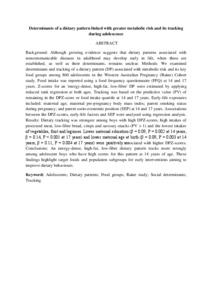Citation
Appannah, Geeta and Pot, Gerda K. and Oddy, Wendy H. and Jebb, Susan A. and Ambrosini, Gina L.
(2018)
Determinants of a dietary pattern linked with greater metabolic risk and its tracking during adolescence.
Journal of Human Nutrition and Dietetics, 31 (2).
pp. 218-227.
ISSN 0952-3871; ESSN: 1365-277X
Abstract
Background: Although growing evidence suggests that dietary patterns associated with noncommunicable diseases in adulthood may develop early in life, when these are established, as well as their determinants, remains unclear. Methods: We examined determinants and tracking of a dietary pattern (DP) associated with metabolic risk and its key food groups among 860 adolescents in the Western Australian Pregnancy (Raine) Cohort study. Food intake was reported using a food frequency questionnaire (FFQ) at 14 and 17 years. Z-scores for an 'energy-dense, high-fat, low-fibre' DP were estimated by applying reduced rank regression at both ages. Tracking was based on the predictive value (PV) of remaining in the DPZ-score or food intake quartile at 14 and 17 years. Early-life exposures included: maternal age; maternal pre-pregnancy body mass index; parent smoking status during pregnancy; and parent socio-economic position (SEP) at 14 and 17 years. Associations between the DPZ-scores, early-life factors and SEP were analysed using regression analysis. Results: Dietary tracking was strongest among boys with high DPZ-scores, high intakes of processed meat, low-fibre bread, crisps and savoury snacks (PV > 1) and the lowest intakes of vegetables, fruit and legumes. Lower maternal education (β = 0.09, P = 0.002 at 14 years; β = 0.14, P < 0.001 at 17 years) and lower maternal age at birth (β = 0.09, P = 0.003 at 14 years; β = 0.11, P = 0.004 at 17 years) were positively associated with higher DPZ-scores. Conclusions: An energy-dense, high-fat, low-fibre dietary pattern tracks more strongly among adolescent boys who have high scores for this pattern at 14 years of age. These findings highlight target foods and population subgroups for early interventions aiming to improve dietary behaviours.
Download File
![[img]](http://psasir.upm.edu.my/61417/1.hassmallThumbnailVersion/Determinants%20of%20a%20dietary%20pattern%20linked%20with%20greater%20metabolic%20risk%20and%20its%20tracking%20during%20adolescence.pdf)  Preview |
|
Text
Determinants of a dietary pattern linked with greater metabolic risk and its tracking during adolescence.pdf
Download (76kB)
| Preview
|
|
Additional Metadata
Actions (login required)
 |
View Item |

